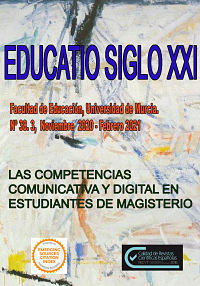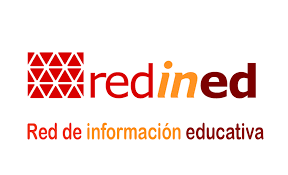Digital textuality practices of high school students when taking notes on Online Dictionaries in the language media library
Abstract
INTRODUCTION. This paper reports on the digital practices of 18 high school students’ when taking notes with the text processor Word about the characteristics of on-line dictionaries—Spanish and English monolingual dictionaries and English-Spanish and Spanish-English bilingual dictionaries. The students explored the dictionaries and, in order to get familiar with them, they worked with the English verb get. The approach implemented refers to literacy in digital textuality. METHOD. The study contemplates the identification of multimedia resources and textual modalities in the dictionaries and the description of digital writing in the notes. Classification and textual analysis involves the informativity criteria identified in the dictionaries: language use, digital searches, textual designs, intertextuality sources, coherence and interactivity, as well as digital cohesion in descriptive and expositive writing, intertextuality by means of images, hyperlinks and lexical and graphic references. RESULTS. The notes show a predominant use of practical tools in the dictionaries in comparison to coherence and interactivity. They also evidence difficulties to integrate expositive and descriptive writing with digital modalities of intertextuality, hypertextuality and referentiality. DISCUSSION. Consideration and identification of various aspects of textuality in dictionaries show various degrees of intentionality and performance through digital and multimodal resources. However, teaching and practice support is necessary to fully appreciate the information, as well as the digital writing in notes.
Downloads
-
Abstract485
-
PDF (Español (España))467
References
Álvarez, G.; González, A. y Bassa, L. (2017). Apuntes para pensar la apropiación de tecnologías en la enseñanza de la lectura y la escritura. En R. Cabello y A. López (Eds.), Contribuciones al estudio de procesos de apropiación de tecnologías (pp. 227-239). Buenos Aires: Ediciones del Gato Gris y Red de Investigadores sobre Apropiación de Tecnologías. Recuperado de https://www.aacademica.org/anahi.mendez/55.pdf
Bausela-Herreras, E. (2007). Relación entre autorregulación y autoconocimiento de la escritura con la coherencia y productividad de un texto. Cuestiones pedagógicas, 18, 257-270.
Blikstad-Balas, M. (2015). Digital Literacy in Upper Secondary School – What do students use their laptops for during teacher instruction? Nordic journal of digital literacy, 10, 9.
Cerić, V. (2013). Digital text: interactivity and intertextuality. Online Journal of art and design, 1(1): 17-31. Recuperado de http://www.adjournal.net/articles/11/113.pdf
Coyle, J. y Thorson, E. (2001). The effects of progressive levels of interactivity and vividness in web marketing sites. Journal of Advertising, 30(3), 13-28.
Cordón, J. A. (2016). La lectura en el entorno digital: nuevas materialidades y prácticas discursivas. Revista chilena de literatura, 94, 15-38.
De Beugrande, R. y Dressler, W. (1997). Introducción a la lingüística del texto. Barcelona: Ariel-Lingüística.
Edwards-Groves, C. J. (2010). The multimodal writing process: changing practices in contemporary classrooms. Language and education, 25(1), 49-64. Recuperado de https://www.tandfonline.com/doi/abs/10.1080/09500782.2010.523468
Gass, S. M. y Mackey, A. (2007). Data elicitation for second and foreign language research. Mahwah: Lawrence Erlbaum Associates.
Gurr, C. A. (1999). Effective Diagrammatic communication: syntactic, semantic and pragmatic issues. Journal of visual languages and computing, 10, 317-342.
Halliday, M. A. K. y Hassan, R. (1976). Cohesion in English. Londres: Longman.
Hernández, E. y Reyes, E. (2015a). Interactividad y textualidad digital para elaborar materiales multimedia con canciones para el aprendizaje de la lengua extranjera en la mediateca del bachillerato. ReLingüística aplicada, 11(17), 7.
Hernández, E. y Reyes, E. (2015b). Manual de recursos para la redacción redacción bilingüe. En Recomendación de textos en inglés y español. Recuperado de: https://recomendacionesbilingues.blogspot.com/2015/10/800x600-normal-0-21-false-false-false_93.html
Hyland, K. (2005), Metadiscourse: exploring interaction in writing. Londres: Continuum.
Hyland, K. (2016). Methods and methodologies in second language writing research. System, 59, 116-125.
Jewitt, C. (2006). Multimodality, “Reading”, and “Writing” for the 21st century. Discourse: studies in the cultural politics of education, 26(3), 315-331. Recuperado de: https://doi.org/10.1080/01596300500200011
Johnson, M. y Nádas, R. (2009). Marginalised behaviour: digital annotations, spatial encoding and the implications for reading comprehension. Learning, media and technology, 34(4), 323-336.
Lea, M. R. y Jones, S. (2010). Digital literacies in higher education: exploring textual and technological practice. Studies in higher education, 36(4), 377-393.
López, M. (2017). Buscar, evaluar y seleccionar información digital: una experiencia didáctica en educación secundaria (Tesis doctoral, Mondragon Unibertsitatea). Recuperado de http://academica-e.unavarra.es/bitstream/handle/2454/26022/Tesis%20Maite%20L%C3%B3pez%20Flamarique.pdf?sequence=1&isAllowed=y
Mayer, E. R. (2002). Cognitive theory and the design of multimedia instruction: An example of the two-way street between cognition and instruction. New directions for teaching and learning, 89, 55–71. Recuperado de: http://onlinelibrary.wiley.com/doi/10.1002/tl.47/abstract
Olza, I. (2014). Nuevas tecnologías y procesos de lectura/escritura: panorama y aplicaciones. En A. Baraibar (Ed.), Humanidades Digitales: una aproximación transdisciplinar (pp. 85-98). Coruña: SIELAE-JANUS.
Oxford, R. (1990). Language learning strategies: What every teacher should know. Boston: Heinle & Heinle/Cengage.
Salas, C. (2011). Los elementos cohesivos en el discurso académico escrito: una experiencia desde el contexto universitario. Legenda, 15(13), 29-55.
Sarena, N. (2006). Los jóvenes e internet: experiencias, representación, usos y apropiaciones de internet en los jóvenes. UNIrevista, 1(3), 1-11.
Serrano-Puche, J. (2013). Vidas conectadas: tecnología digital, interacción social e identidad. Historia y Comunicación Social, 18, 353-364. Recuperado de: http://revistas.ucm.es/index.php/HICS/article/viewFile/44249/41810
Stacy, E. M. & Cain, J. (2015). Note-Taking and Handouts in The Digital Age. American Journal of Pharmaceutical Education, 79(7), 107.
Tyrkkö, J. (2007). Making sense of digital textuality. European journal of English studies, 11(2), 147-161. Recuperado de: https://www.tandfonline.com/doi/pdf/10.1080/13825570701452722?needAccess=true
Waller, R. (2012). Graphic literacies for a digital age: The survival of layout. The Information society, 28(4), 236-252.
Wenden, A. (1986). Helping language learners think about learning. ELT journal. An international journal for teachers of English to speakers of other languages, 40(1), 161-175.
Whitman, L. (2009). The Effectiveness of interactivity in computer-based instructional diagrams. En Jacko, Julie A. (Ed.), Human computer interaction, 2, 889-908.
Original work publishes in this journal is subject to the following terms:
1. Murcia University Press (the publishing house) holds the copyright of the publishes work, and favours and allows their reutilization under the use license stated in point 2.
© Servicio de Publicaciones, Universidad de Murcia, 2015
2. Work is published in the electronic edition under a license (Creative Commons Reconocimiento-NoComercial-SinObraDerivada 4.0 España (legal text). They can be copied, used, disseminated, transmitted and publicly presented, as long as: i) authorship and original publication source is acknowledged (journal, publishing house and URL of the work); ii) are not used for commercial purposes; iii) the existence and specifications of this use license is stated.
3. Conditions for self-archive. Authors are allowed and encouraged to disseminate electronically the pre-pint (before review) and/or post-print (accepted for publication) versions of their work before their publication since that favours earlier circulation and dissemination resulting in an increased chance for the authors to be cited and for the work to reach a bigger share of the academic community. Colour: RoMEO: green.








